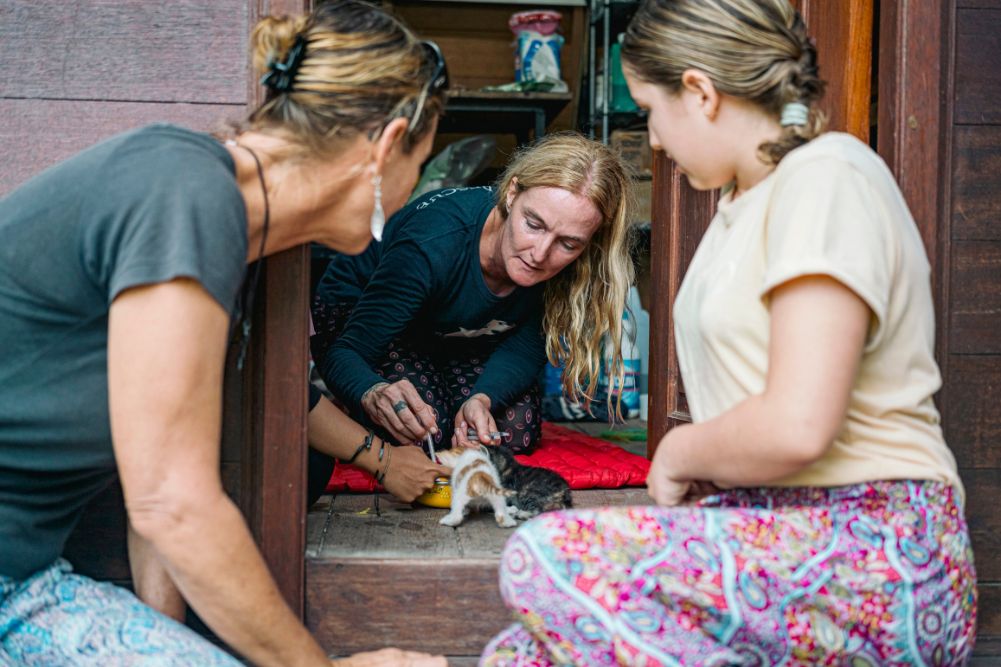The what and why of effective altruism
Altruism and rationality aren’t the most commonly accepted of bedfellows. Recent neurological studies show our brains are hardwired to want to help others without expecting anything in return. Scientists aren’t sure how this came to be, but selflessness is most often associated with emotion, not logic.
Biological theories to explain altruism include that such actions are limited to helping our family, social groups or those we need — or may need — to survive. Neurological and psychological research into generosity, meanwhile, has found it delivers a great sense of purpose, social rewards and a dopamine hit. When we’re choosing how to give, MRI technology shows the frontal lobes of the brain — the region that helps with social reasoning and decisions about what course of action to take — are active, but it’s the brain’s pleasure and reward circuits that really light up.
So we’re wired to give, and it makes us feel good. And, whatever the evolutionary roots of altruism, we mostly give to what tugs at the heartstrings.
The statistics agree. Aussies donated $10.5 billion to charities in 2016, according to data from the Australian Charities and Not-for-profits Commission. Some gave in a planned and strategic way, donating a large sum to an issue or organisation they cared deeply about. Most donors gave monthly donations to their favourite charity, or a one-off sum for causes such as a Christmas or disaster appeal. Meanwhile 2.9 million of us volunteered, mostly for religious, “other education” or emergency relief charities.
Common reasons for choosing a charity, a Giving Australia 2016 report shows, include: it’s a good cause; the donor has the condition it is trying to cure or knows someone who’s benefited from its work; and sympathy for those it helps.
Effective altruism (EA) challenges all of this. A philosophy and social movement that encourages you to do the most good you can do, EA is about making highly rational decisions to maximise the welfare of all living beings. Effective altruists use empirical evidence and reason to determine the effectiveness of a charity or initiative, and then direct their resources— money and time — based on this data.
How it started
Effective altruism has its roots in the work of Peter Singer, a moral philosopher best known for his work on animal ethics and global poverty. Singer’s thinking is informed by utilitarianism. This philosophical tradition, according to the Stanford Encyclopedia of Philosophy, holds: a) our actions are right or wrong depending on the extent to which they promote happiness or prevent pain; and b) it’s our moral duty to maximise the overall good — that is, bring about the greatest good for the greatest number — with everyone’s happiness valued the same.
In his influential 1972 essay Famine, Affluence, and Morality, Singer wrote that people should donate money to address serious suffering “up to [and perhaps even beyond] the point at which by giving more one would begin to cause serious suffering for oneself and one’s dependents”.
Effective altruism measures how effective interventions are at maximising overall good, and uses those metrics to guide altruistic actions.
He has also long argued that, as all human lives are equal, and people living in wealthy countries are well off in absolute terms, we’re morally obliged to do much more for people in faraway places. So, for example, our obligation to rescue a child we see drowning in a pond is at least as strong as our obligation to donate to agencies that help a child dying of malaria abroad.
The effective altruism movement arose out of Singer’s arguments. It retains his emphasis on the moral duty to give, but adds another element: measuring how effective interventions are at maximising overall good, and using those metrics to guide altruistic actions.
As Jennifer Rubenstein, associate professor of politics at the University of Virginia, writes in the journal Ethics & International Affairs, EA had “two founding moments”.
Two philosophy graduate students at Oxford, William MacAskill and Toby Ord, started to research the cost-effectiveness of charities fighting global poverty in the mid-2000s. In 2009, they founded Giving What We Can, a “meta-charity” that evaluates other charities and encourages people to donate at least 10 per cent of their income to charities with the greatest positive impact.
Around the same time, two hedge-fund analysts, Holden Karnofsky and Elie Hassenfeld, independently started GiveWell. This non-profit uses in-depth research to identify charities that do the most good, as judged by four criteria: evidence of effectiveness, cost-effectiveness, transparency and room for more funding.
A community formed around these two groups and has grown swiftly. In April 2019, Giving What We Can had more than 4000 members who had donated more than US$126 million to “effective charities”.
Efforts to promote EA principles now extend to other meta-charities, charities influenced by the movement, global chapters, TED Talks, conferences, research papers, advocacy groups and websites helping people choose impactful work. Associated organisations include:
- 80,000 Hours — a non-profit helping people choose meaningful, high-impact careers.
- The Life You Can Save — an advocacy group based on Singer’s book by the same name. According to its website, it aims “to inspire people to help the world’s poor, and … empower them to make the greatest impact possible”.
- Open Philanthropy Project — an offshoot of GiveWell whose mission is to: give grants in order to do the most good; conduct research; and share its findings openly so others can build on its work.
- Animal Charity Evaluators — which its website says is about “finding and promoting the most effective ways to help animals”.
The EA approach
Effective altruists focus heavily on number crunching and analysis. Data allows EA researchers to measure various interventions, even if roughly, and assess which ones do the most good — or are highly likely to do great good in the future. Understandably, effective altruists see transparency in charitable organisations as vital.
To assess which causes are most effective, EA uses a framework developed by the Open Philanthropy Project together with staff at the Future of Humanity Institute, a research group at the University of Oxford that advises policymakers and major decision-makers on how to prioritise global problems.
According to Effective Altruism, working on a cause is likely to be high impact to the extent that it is:
- Great in scale (it affects many people’s lives, by a great amount);
- Highly neglected (few other people are working on addressing the problem); and
- Highly solvable (additional resources will do a great deal to address it).
Assessing what work does the most good remains an open — and tricky — question, the website acknowledges. After all, is it better to save a child from a preventable disease or lift an entire family out of poverty? And how do you factor suffering into sums? But, for effective altruists, such comparisons are necessary as these allow them to help others as much as possible.
Effective altruists focus heavily on number crunching and analysis. Data allows EA researchers to measure various interventions and assess which ones do the most good — or are highly likely to do great good in the future.
GiveWell’s approach to ranking charities helps explain how EA uses evidence-based analysis to measure effectiveness. One of GiveWell’s top-rated charities is the Against Malaria Foundation (AMF). It’s a cost-effective, highly transparent non-profit providing cheap insecticide-treated bed nets to prevent malaria in affected countries. In its detailed evaluation of AMF, GiveWell draws on small-scale, randomised controlled trials to assess how effective bed nets are at saving children’s lives. This data allows it to know how many nets can save a life, and how much money AMF requires to buy and distribute that many nets. It’s got a solid estimate of what your dollars can achieve on the ground.
Most EA groups focus on work that addresses social problems they see as most pressing and have easily quantifiable effects, such as reducing poverty and improving global health. Other effective altruists support causes such as improving animal welfare and safely developing artificial intelligence for long-term future good.
Effective altruists assert that the causes they support aren’t fixed. They are best guesses about where you can have the most impact, based on current evidence.
Not all EA organisations share GiveWell’s stringently evidence-based approach, explains Catherine Low, a spokesperson for Effective Altruism New Zealand. “Other EA organisations focus on interventions we’re not sure work — but if they work they will be having a very large impact.
“Some charities EA organisations recommend include: the environmental organisation Coalition for Rainforest Nations, which has successfully lobbied for wealthy countries to support low-income countries to protect their rainforest; the Good Food Institute, which aims to reform our agriculture system away from using animals; as well as many organisations that aim to improve policy to reduce risks from new technology.”
EA in practice
So what does it mean to be an effective altruist? Maths skills and a love of spreadsheets? To an extent, yes. And a desire to help, too.
Typically, as Singer writes in his book The Most Good You Can Do, effective altruists are millennials who respect the scientific method. Given that EA arose partly in Oxford University, and has been embraced by Silicon Valley’s tech community (so much so that GiveWell relocated to San Francisco in 2013), this makes sense.
Singer talks of Matt Wage, a student who took his moral ethics course at Princeton. Wage learned how much it would cost to save the life of a child dying from preventable diseases, and calculated how many lives he could save, over his lifetime, if he earned an average income and gave away 10 per cent to an effective charity. At that rate, he discovered, he could save 100 lives.
When Wage graduated two years later, he was accepted into Oxford for postgraduate study but turned it down. Instead of entering academia, Wage took a job as a trader on Wall Street, as he decided he’d be able to give much more — and save more lives — on a higher income. One year later and he was donating a six-figure sum, or about half of his annual salary, to charity.
Singer donates approximately one-third of his income to effective charities. Giving What We Can founder Toby Ord is reported to live on £18,000 a year and donate the rest of his income to charity. These cases demonstrate the EA principle of “earning to give”, but MacAskill emphasises that not all effective altruists are ascetics.
“You should spend a good amount of your money trying to make the world as good a place as possible,” MacAskill told The Atlantic. “But you shouldn’t beat yourself up for not donating all your money.” For most people, he said, it’s more realistic to give a little more than you do now and to donate to charities with proven outcomes.
As well as living modestly and donating some of their income, or tithing, to charities they support, Singer writes that effective altruists do things like the following:
- Researching and discussing with others which charities are the most effective or drawing on research done by other independent evaluators;
- Choosing a career that allows them to earn the most, so they can give more and do more good;
- Talking with others about giving, to spread the idea of EA; and
- Donating a part of their body to a stranger.
Low, who used to be a physics and science teacher, has long been interested in how humans have an impact on the environment and how science can make the world a better place. She says she was drawn to EA by its evidence-based approach to doing good, and has since changed her habits in a few ways.
Low has become more careful with spending, as she knows the potential good her dollars can do. She’s aware of how the meat industry harms both animals and the environment, so she now eats mostly plants. And she gives both money and time. “Over the past five years, I’ve donated 10 per cent of my income to charity,” Low shares. She’s been teaching others about EA in her spare time since 2015, and early last year swapped teaching for a role producing educational resources about the movement with an EA organisation.
A reasonable approach?
Effective altruism isn’t alone in advocating for transparency and accountability within philanthropy. Concerns about how monetary donations are used is a big reason why many of us don’t give, the Giving Australia 2016report found. And charities have made moves to respond, releasing more data about how they allocate resources.
What’s different about EA is how committed its organisations and community are to doing substantial, evidence-based research before deciding on a cause to back. And its insights are helpful for anyone who wants their money to do the most good.
When assessing a charity’s impact, most people focus on how much it spends on overhead versus program costs. As Rubenstein writes in Ethics & International Affairs, “EA tells us that this figure is virtually meaningless; what matters is the amount of good that an organisation accomplishes (and the harm it inflicts) per dollar spent, regardless of whether that dollar is categorised as [an] overhead or program cost.
“Likewise, while donors frequently prioritise causes in which their donation will address all or almost all of a problem, EA suggests that we should focus instead on the absolute size of our contribution,” Rubenstein adds.
Despite its strengths, numerous criticisms have been levelled at effective altruism. Two common ones are:
- EA is biased towards causes that can be easily measured. Critics argue that EA neglects valuable but less easily measurable interventions that would create the kind of institutional change that could address poverty. Low agrees that some EA organisations focus on charities with high-quality evidence they’re effective. But she says other groups focus on finding charities in other, less certain areas. “To do as much good as we can, we do some work we’re certain is effective, then also try to work on some of the most promising interventions that are harder to measure.”
- Recipients of EA’s work aren’t involved in decision-making. It’s been argued that effective altruists are wealthy elites who don’t understand or address the needs of those they want to help. The community acknowledges this is an issue, and one they’re vigilant about. Low points to GiveDirectly as a charity that engages with its recipients well. “[It] gives unconditional funds directly in the hands of the poor so they can decide how to best help themselves,” she says. “It also publishes detailed reports on how they feel about their grant and how they spent their money.” It’s harder to gauge how people feel about, say, bed nets — but surveys help the community learn if people found an intervention useful.
Effective altruism has its limitations, but it also has some powerful and useful arguments. Next time you give, perhaps it’s worth weighing up the options rather than just going with your gut.








